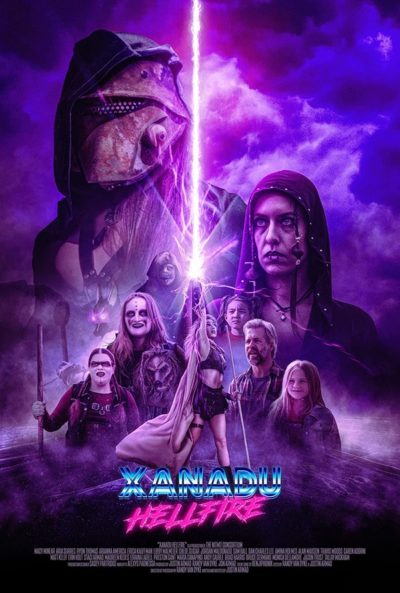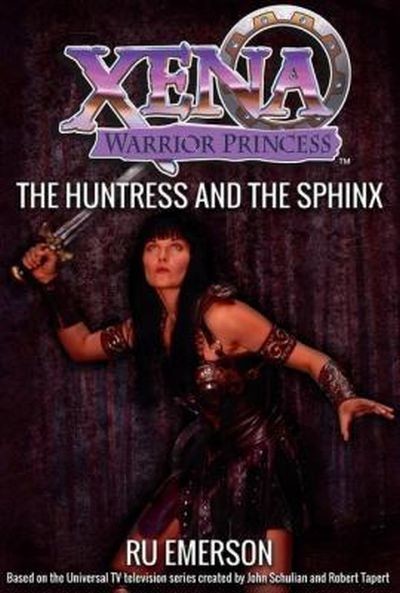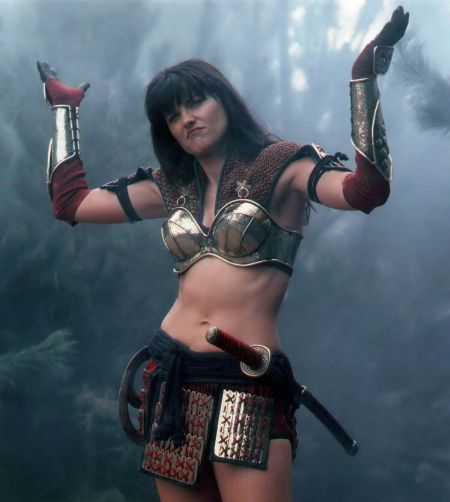★★½
“Olivia Newton-John not included.”
 I went into this braced for it to be terrible, having sat through the same film-makers’, largely irredeemable Bloodsucka Jones vs. The Creeping Death. Fortunately, this is considerably better. Still very cheap and flawed, yet is at least aware of its own limitations, and tries to work inside them (albeit with mixed success). It’s about eight-year-old Ruby (Surrec), who lives with her single parent Dad, Steven (Thomas), and is obsessed with comic-book heroine, Xanadu Hellfire (Minear). For her birthday, Ruby wants to stage a ritual from the comic, and bring Xanadu back from her post-apocalyptic future. Dad humours her – at least until the ritual works, and Xanadu arrives, with wicked stepsister Raven (America) on her heels.
I went into this braced for it to be terrible, having sat through the same film-makers’, largely irredeemable Bloodsucka Jones vs. The Creeping Death. Fortunately, this is considerably better. Still very cheap and flawed, yet is at least aware of its own limitations, and tries to work inside them (albeit with mixed success). It’s about eight-year-old Ruby (Surrec), who lives with her single parent Dad, Steven (Thomas), and is obsessed with comic-book heroine, Xanadu Hellfire (Minear). For her birthday, Ruby wants to stage a ritual from the comic, and bring Xanadu back from her post-apocalyptic future. Dad humours her – at least until the ritual works, and Xanadu arrives, with wicked stepsister Raven (America) on her heels.
From here, things progress more or less as you expect. Xanadu has to adapt to life in contemporary society (I did laugh at her going to Ruby’s school, where the battle-bikini clad warrior princess is described as “an exchange student from Canada”). She bonds with Ruby, partly because she reminds the moppet of her absent mother. Conveniently, Xanadu and Mom take the same size in clothes, as we find out during a dress-up montage. Raven shows up, and “wreak havoc” as she and her sidekicks search for Xanadu. Xanadu, Ruby, Dad, some of Dad’s loser friends from high-school team and Ruby’s best friend, Becky, team up to take on Raven and Co.
It’s a super mixed bag of elements that are fun, and stuff which borders on the cringe. Sometimes, both are in close proximity. For example, Minear looks really good twirling her staff. But as soon as she goes into hand-to-hand combat, she slows down to about one-tenth of the speed. While I admire the avoidance of hyper-kinetic editing, the lengthy shots only exacerbate this problem. The comedy which doesn’t hit, misses by a mile, such as an extended joke about characters walking about in slow-motion. It doesn’t help that Ruby’s lines never sound like something an adorable eight-year-old would say e.g. “Eat shit, Frankenhooker!”. Yet some elements are genuinely funny, such as the way Raven’s minions team up with the local Goth girl. This leads to the exchange, “I thought you were dead?” “Only on the inside…”
It’s at its best when obviously not taking itself seriously. For instance, Becky going up to a minion before the final battle, and saying, “I like your make-up. Do you need a hug?” Sadly what follows is far from the climactic conflict the movie needs, and at 107 minutes long, this is in serious need of significant trimming. There was also surprisingly little difference between the post-apocalyptic world and the modern one, though this might have been a deliberate joke. Or it might not. The ending teases a sequel, which I’m all in favour of, providing it stops the makers from doing another Bloodsucka Jones movie. For I would be at least cautiously interested in seeing Xanadu’s further adventures, as despite the flaws here, there is genuine heart at its heart.
Dir: Justin Armao
Star: Macy Minear, Aria Surrec, Ryon Thomas, Arianna America





 I can’t believe there have been seven X-Men movies now. I think the last I saw was the second, which came out in 2003. Since then, there seems to have been a lot of mutants under the bridge, so to speak – and, it appears, some jiggery-pokery with timelines. That’s the only way to explain the death early on in this origin story, of someone I’m
I can’t believe there have been seven X-Men movies now. I think the last I saw was the second, which came out in 2003. Since then, there seems to have been a lot of mutants under the bridge, so to speak – and, it appears, some jiggery-pokery with timelines. That’s the only way to explain the death early on in this origin story, of someone I’m 
 I used to be a Xena fan; for the first couple of series, I was a die-hard, never missed an episode, bought the merchandise, went to the gatherings, etc. I loved (with one exception) the supporting cast – Joxer, Ares, Autolycus – and still reckon Callisto remains one of the great TV villainesses of all time.
I used to be a Xena fan; for the first couple of series, I was a die-hard, never missed an episode, bought the merchandise, went to the gatherings, etc. I loved (with one exception) the supporting cast – Joxer, Ares, Autolycus – and still reckon Callisto remains one of the great TV villainesses of all time.
 The defining moment of Xena’s sophomore season didn’t take place in any episode. In fact, it didn’t even take place in New Zealand, but thousands of miles away, During a rehearsal for an appearance on The Tonight show with Jay Leno, Lucy Lawless was thrown off a horse after it lost its footing, and broke her pelvis. It’s interesting to compare the reaction of the producers to what the Tapert/Raimi team did when the star of Spartacus, Andy Whitfield, was similarly a victim of severe misfortune, more than a decade later. There, they put the show entirely on hold and opted instead to film a prequel without him.
The defining moment of Xena’s sophomore season didn’t take place in any episode. In fact, it didn’t even take place in New Zealand, but thousands of miles away, During a rehearsal for an appearance on The Tonight show with Jay Leno, Lucy Lawless was thrown off a horse after it lost its footing, and broke her pelvis. It’s interesting to compare the reaction of the producers to what the Tapert/Raimi team did when the star of Spartacus, Andy Whitfield, was similarly a victim of severe misfortune, more than a decade later. There, they put the show entirely on hold and opted instead to film a prequel without him. In terms of style and approach, the show covers even more ground here than the first time, from absolutely froth to grim darkness. Xena even gets crucified by Julius Caesar in one episode [confusingly, the actor responsible also crops up later, playing Cupid, complete with fluffy wings…]. I’m sure I’m not the only one who found themselves whistling Always Look on the Bright Side of Life, during the scene shown above right. Another unwitting Python reference is the wretched Here She Comss, Miss Amphipolis, a dreadful tale of drag-queen empowerment, featuring perhaps the least convincing female impersonator since John Cleese put on a dress – as on the left, watch that Adam’s apple
In terms of style and approach, the show covers even more ground here than the first time, from absolutely froth to grim darkness. Xena even gets crucified by Julius Caesar in one episode [confusingly, the actor responsible also crops up later, playing Cupid, complete with fluffy wings…]. I’m sure I’m not the only one who found themselves whistling Always Look on the Bright Side of Life, during the scene shown above right. Another unwitting Python reference is the wretched Here She Comss, Miss Amphipolis, a dreadful tale of drag-queen empowerment, featuring perhaps the least convincing female impersonator since John Cleese put on a dress – as on the left, watch that Adam’s apple  It’s assumed viewers are at least somewhat familiar with Xena’s background, as she is first seen burying her armour in an effort to bury her past. Of course, this is about as successful as it usually is in fiction, and it’s not long before she’s saving villagers, including Gabrielle, from slavery. That includes an aerial battle atop platforms, which is the first sign of the show’s strong influence from Hong Kong action films; it was using wirework, in a way that predated its popular arrival in Hollywood. Similarly, the stunning New Zealand locations foreshadow Lord of the Rings, to the extent that I kept expecting to see hobbits gamboling along in Xena’s wake.
It’s assumed viewers are at least somewhat familiar with Xena’s background, as she is first seen burying her armour in an effort to bury her past. Of course, this is about as successful as it usually is in fiction, and it’s not long before she’s saving villagers, including Gabrielle, from slavery. That includes an aerial battle atop platforms, which is the first sign of the show’s strong influence from Hong Kong action films; it was using wirework, in a way that predated its popular arrival in Hollywood. Similarly, the stunning New Zealand locations foreshadow Lord of the Rings, to the extent that I kept expecting to see hobbits gamboling along in Xena’s wake.